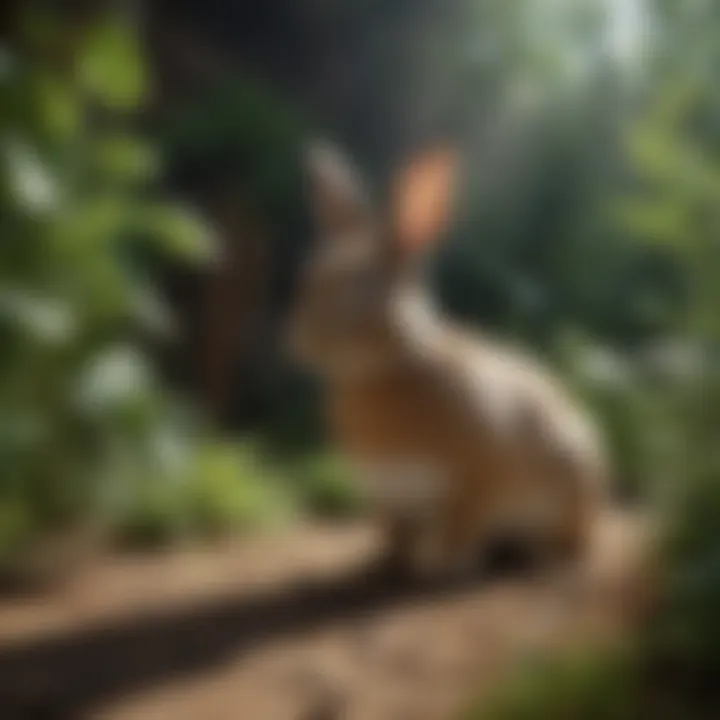Comprehensive Insights on Effective Rabbit Repellents


Intro
Understanding how to manage the presence of rabbits in garden and outdoor spaces is crucial for many homeowners and gardening enthusiasts. Rabbits, while often seen as charming creatures, can also cause substantial damage to plants. Effective rabbit repellents can help mitigate this damage, allowing for a balance between wildlife and gardening aesthetics. This article aims to provide insightful information regarding the various repellents available, their effectiveness, and practical application methods.
Rabbits are attracted to gardens primarily for food sources. They nibble on young plants, vegetables, and flowers. Knowing the motivations behind rabbit behavior can enhance the effectiveness of chosen repellents. This guide will delve into the analytical assessment of different repellents and discuss how they can be used effectively in your outdoor spaces.
Key points include:
- The rationale for rabbit control
- Various methods employed for effective deterrence
- A detailed analysis of top rabbit repellent products
- Practical advice for homeowners and gardening aficionados
Ultimately, the goal is to help readers make informed decisions about rabbit repellents and ensure their gardens thrive without undue interference from wildlife.
Understanding Rabbit Behavior
Understanding rabbit behavior is crucial when addressing how to effectively manage their presence in gardens and yards. Knowing their habits, instincts, and preferences helps in designing better repelling strategies. By accurately identifying their behavior patterns, homeowners can implement more effective measures that yield positive results.
Rabbits are crepuscular animals, meaning they are most active during dusk and dawn. This activity pattern is important because it affects their feeding times and movement through the landscape. Understanding this will help gardeners time their repellent applications effectively. Furthermore, acknowledging the social structure within rabbit communities provides insight into their foraging habits and territorial behaviors. Motivations behind their movement can include seeking food, shelter, and mating opportunities.
Additionally, recognizing the seasonal patterns in rabbit behavior is essential. For instance, during spring and summer, their food intake increases due to the abundance of fresh vegetation. In contrast, winter forces them to adapt, often leading them to chew on tree bark or shrubs. By comprehending these seasonal changes, one can anticipate potential damage and take preemptive steps to protect vulnerable areas of their garden.
Overview of Rabbit Habits
Rabbits have a series of distinct habits that characterize their daily lives. Their need for safety influences how and where they forage. Usually, rabbits prefer areas that provide good cover. They often graze in open spaces but will retreat to thicker shrubs or ground cover at the slightest sign of danger. This instinctual behavior significantly shapes their feeding locations.
Social structure plays an important role as well. In the wild, rabbits usually live in groups for protection against predators. Their hierarchical behaviors can dictate where they feed and when. Dominant rabbits will often have first access to food sources, which can lead to competition among group members. Thus, understanding the group dynamics is vital.
Common Feeding Patterns
Rabbits' feeding patterns revolve around their preference for specific types of vegetation. Generally, they are herbivores that enjoy a variety of plants, including grasses, clovers, and leafy vegetables. However, they have specific tendencies when it comes to their diets. They appear to favor young, tender shoots and foliage over mature plants, making fresh growth particularly vulnerable during certain seasons.
Another notable aspect is their selective feeding. Rabbits may nibble on certain plants while avoiding others, often based on taste or scent. For instance, many gardeners find that their gardens are targeted by rabbits seeking out sweet carrots or crisp lettuce.
Rabbits are also known for their habit of eating in short spurts. They tend to graze for a short period before moving on to a different spot. This behavior can lead to inconsistent damage in gardens, where one area may be devastated while another nearby is left untouched.
Understanding these feeding patterns enables homeowners to design their gardens in a way that minimizes the appeal to rabbits. By choosing plants that rabbits typically avoid or employing repellents proactively, gardeners can create a garden that discourages rabbit intrusion.
The Impact of Rabbits on Gardens
Understanding the impact of rabbits on gardens is essential for anyone who cherishes their outdoor spaces. Rabbits can cause significant harm to a garden, leading to physical destruction of plants and creating aesthetic issues. They are known for their insatiable appetite, which can lead to the complete decimation of delicate flowers, vegetables, and shrubs. This topic delves into the specific damage they inflict and the broader economic considerations faced by gardeners. Recognizing these impacts is crucial for developing an effective rabbit management strategy.
Identifying Damage Caused by Rabbits
Identifying the damage caused by rabbits is not a complex task. The signs are usually quite clear. Some common indicators include:
- Gnawed Stems and Leaves: Rabbits tend to munch on tender shoots and leaves. You may find clean, angled cuts on the ends of stems, indicating they have been bitten off.
- Missing Plants: In severe cases, entire plants may be uprooted, especially young seedlings.
- Droppings: Rabbit droppings look like small pellets and are often scattered around their feeding areas.
These indicators serve as a straightforward way to assess the extent of the damage in your garden. By being vigilant and recognizing these signs early, actions can be taken promptly to mitigate further harm.
Economic Implications for Gardeners
The economic implications of rabbit-related damage can be considerable. When rabbits invade a garden, they threaten not only the aesthetic appeal but also the economic viability of gardening ventures.
For home gardeners, the cost of replacing damaged plants and seedlings can add up quickly. If a gardener invested time and money into growing vegetables for personal consumption, the loss can discourage future gardening efforts.
For larger scale operations, such as nurseries or farms, the losses can be even more pronounced. Rabbits can lead to:
- Loss of Crop Yield: Reduced harvests can impact income significantly, affecting overall profits.
- Increased Costs: Gardeners may incur additional costs for purchasing rabbit repellents or physical barriers to protect their plants.
- Labor Loss: The time spent dealing with rabbit damage could have been invested in developing other areas of the garden.
Overall, recognizing the impact of rabbits is a vital first step. It prepares gardeners to take action and implement effective strategies to manage these animals effectively.
"Understanding the full scope of rabbit damage empowers gardeners to devise strategies to protect their gardens and optimize their investments in time and resources."
By addressing the specific impacts outlined here, gardeners can better appreciate the importance of adopting effective repellents and deterrents.


Different Types of Rabbit Repellents
Effective rabbit repellents are crucial for protecting gardens and outdoor spaces from these persistent pests. Understanding the different types of repellents available allows homeowners to select methods that suit their specific needs and environments. This section provides an overview of chemical repellents, natural deterrents, and physical barriers. Each type has its own set of benefits and drawbacks that merit consideration.
Chemical Repellents
Chemical repellents are often the go-to option for those seeking quick results in keeping rabbits at bay. These products typically contain active ingredients that create an unpleasant taste or scent for rabbits, discouraging them from nibbling on plants. Common ingredients include bittering agents, predator urine, and various essential oils.
When using chemical repellents, application techniques are essential for maximizing their effectiveness. Homeowners should apply these products evenly and reapply them after rain or watering. However, it is critical to select safe products, especially if pets or children are present in the area. Read the labels carefully to ensure the product is appropriate for use in gardens where food is grown. They can be beneficial in providing immediate results, but over time, rabbits may become accustomed to these products, reducing their effectiveness.
Natural Deterrents
Natural deterrents provide an alternative to chemical options, focusing on environmentally friendly ingredients. Many gardeners turn to these methods due to increasing awareness of the impacts of chemicals on wildlife and ecosystems.
Some common herbal solutions include plants like rosemary, mint, and sage, which not only repel rabbits but also enhance the garden's aesthetic and biodiversity. Essential oils, such as peppermint and cinnamon oil, are also effective. These natural methods often require regular application, especially after rainfall, but they contribute to a healthier gardening environment. Both herbal solutions and essential oils are considered less hazardous, yet they may take longer to show results compared to chemical repellents.
Physical Barriers
Physical barriers form a direct line of defense against rabbits and are often lauded for their effectiveness. Fencing is the most common type of physical barrier. Homeowners should ensure that fences are at least three feet tall and buried at least six inches underground to prevent rabbits from burrowing underneath.
Other physical methods include trapping and netting. While traps can provide immediate removal of pests, they require monitoring and maintenance. Netting can protect specific plants or garden areas from rabbit access. One downside to physical barriers is that they can be labor-intensive to create and maintain. They may also limit access for beneficial wildlife. Nonetheless, when installed and implemented properly, physical barriers can provide long-lasting solutions.
"Understanding the various types of rabbit repellents is essential for effective garden management and wildlife coexistence."
How Chemical Repellents Work
Chemical repellents play a crucial role in managing rabbit populations, especially in gardens and landscaped areas. These products have been developed to deter rabbits effectively, utilizing various biochemical compounds to target their senses. Understanding how these repellents work can help homeowners make informed decisions about their use, enhancing the overall health of their gardens while minimizing the impact of rabbits.
One of the primary benefits of chemical repellents is their effectiveness in masking the scent of plants. This can confuse rabbits, who rely heavily on their sense of smell to locate food. Additionally, some chemical repellents may taste unpleasant, further discouraging rabbits from consuming treated plants. It's important to note that while chemical repellents can be effective, they are often part of a broader strategy that includes other deterrent methods for maximum efficacy.
Active Ingredients in Chemical Products
Chemical rabbit repellents often contain various active ingredients that contribute to their repellent properties. For example, substances like bittering agents are added to make plants taste unpalatable to rabbits, making them less likely to eat them. Some common active ingredients include:
- Capsaicin: Derived from hot peppers, this compound gives a burning sensation to animals attempting to consume the treated vegetation.
- Putrescent Egg Solid: This ingredient mimics the smell of decay, which can alert rabbits to danger and deter them from the area.
- Garlic Oil: Known for its pungent aroma, garlic oil may repel rabbits due to its strong scent.
In addition to the active ingredients, many of these products are formulated with adhesives that help the repellent cling to foliage, enhancing its longevity and effectiveness during rain or watering. It's advisable to check the product labels for information on concentration levels and specific formulations.
Application Techniques
Applying chemical repellents correctly maximizes their effectiveness against rabbits. Here are some key techniques to consider:
- Timing of Application: Apply repellents during early spring, as rabbits become more active and begin foraging for fresh growth. Reapply regularly, especially after heavy rains.
- Coverage Area: Ensure thorough coverage of the plants by spraying on all sides, particularly the lower leaves. This increases the likelihood of contact with rabbits.
- Use of Sprayers: A pressure sprayer can provide an even coat. However, for smaller areas or individual plants, a hand-held spray bottle may suffice.
- Follow Instructions: Always adhere to the manufacturer's instructions for application rates and methods. Over-application can lead to plant damage or reduced effectiveness of the product.
- Monitor Results: After application, observe the garden for signs of rabbit activity. If rabbits persist, consider adjusting the frequency of application or exploring additional methods of deterrence.
By understanding the active ingredients and employing effective application techniques, homeowners can use chemical repellents as a powerful tool in keeping gardens safe from rabbits without compromising the overall health of their plants.
Important Note: Using chemical repellents should always be done responsibly, considering their environmental impact and ensuring they do not harm beneficial wildlife.
Exploring Natural Deterrents
Natural deterrents serve an important role in our efforts to manage rabbit populations in garden settings. These methods prioritize using substances and practices derived from nature, aiming to repel rabbits without relying on harmful chemicals. Homeowners seeking to protect their gardens often encounter challenges with rabbits that enjoy munching on their prized flowers and vegetables. Natural deterrents offer an eco-friendly and often more sustainable option for those looking to create a harmonious environment in which both gardens and wildlife can coexist.
The significance of exploring natural deterrents lies in their accessibility and relative safety for both humans and the environment. Many gardeners find that these solutions can be implemented easily and affordably, allowing for a proactive approach to rabbit management. Additionally, such deterrents often align with organic gardening practices, which are increasingly gaining traction among environmentally-conscious individuals. This section will delve into specific herbal solutions and essential oils, both of which have been used as effective rabbit repellents.
Herbal Solutions
Herbal solutions have a long history as a means to deter rabbits from gardens. Various plants are known for their strong scents or bitter flavors, which can make them undesirable to rabbits. Some commonly used herbs include:
- Mint: The strong aroma of mint can effectively mask more appealing scents in the garden.
- Lavender: Often prized for its fragrance, lavender can deter rabbits due to its potent scent.
- Rue: This herb has a particularly bitter taste that can discourage consumption by rabbits.
Incorporating these herbs into the garden can serve dual purposes. Not only do they work as repellents, but they also enrich the garden's aesthetic and promote biodiversity. Planting these herbs strategically around vulnerable plants might create a natural barrier against rabbit invasions. While these methods are not fail-proof, their effectiveness can vary depending on factors such as the local rabbit population's preferences and the condition of the surrounding environment.
Essential Oils and Their Efficacy
Essential oils serve as concentrated forms of herbs and can be an effective way to deter rabbits. They are often easier to apply than live plants and can be used in more targeted manners. Some essential oils known for their efficacy in rabbit deterrence include:


- Peppermint Oil: The strong scent of peppermint can confuse and repel rabbits; many users report success when applying it around garden perimeters.
- Rosemary Oil: Like peppermint, rosemary has a pungent aroma that can deter rabbit activity.
- Eucalyptus Oil: The fresh scent of eucalyptus can make gardens less inviting to rabbits that are sensitive to strong smells.
To use essential oils effectively, mixing a few drops with water and spraying it around the garden may enhance their repellent properties. It is recommended to reapply these solutions regularly, especially following rainfall, to maintain their effectiveness. Beyond just repelling rabbits, these oils can carry their own set of benefits, including potential pest control properties against other garden nuisances.
"Utilizing natural deterrents not only helps protect gardens but also promotes a more sustainable approach to wildlife management."
In summary, exploring natural deterrents highlights the potential for eco-friendly solutions in keeping rabbits at bay. By integrating herbal solutions and essential oils, gardeners can work towards a peaceful coexistence with wildlife while preserving their beloved plants.
Physical Barriers: Pros and Cons
Utilizing physical barriers for rabbit control is a crucial aspect of maintaining gardens and landscaped areas. These barriers are designed to prevent rabbits from accessing specific areas where they may cause damage. By understanding the pros and cons of employing such strategies, homeowners can make better decisions regarding their effectiveness.
On one hand, physical barriers can provide a long-term solution. Unlike chemical repellents, which require consistent reapplication, properly constructed barriers can last several seasons. This not only saves time but also reduces the need for various chemical products that may harm the environment. Additionally, physical barriers are versatile; they can be adapted to fit various landscaping layouts and suit the specific needs of the garden.
However, there are limitations to consider. Construction and installation require effort, time, and some level of financial investment. The materials used may degrade over time, necessitating maintenance or replacement. Furthermore, if the barrier is not installed correctly, it may fail to serve its purpose, allowing rabbits to slip through or burrow underneath.
"Physical barriers can effectively deter rabbits when they are well planned and properly executed."
Fencing Techniques
Fencing is one of the most popular methods for creating physical barriers against rabbits. To be effective, fences should be at least 2 to 3 feet high and buried about 6 to 12 inches underground. This ensures that rabbits cannot jump over or dig beneath the barrier. Different materials can be used, including wire mesh, wood, or plastic.
When choosing fencing materials, it is essential to consider durability against weather elements. Wire mesh, for example, is strong and allows for airflow, but it may rust if not treated.
There are also various fencing designs, such as:
- L-Shape Fences: Extend the lower part of the fence into the ground, creating a more challenging barrier for rabbits.
- Double Barriers: A second fence placed some distance from the main fence can discourage rabbits from attempting entry.
- Electrical Fences: These add an extra layer of deterrent by delivering a mild charge when touched.
Trapping Options
Trapping can be an alternative or supplementary method alongside fencing. This technique involves setting traps to catch and relocate rabbits humanely. Various types of traps exist, like box traps and live catch traps, which ensure the rabbit is not harmed during the process.
When using traps, placement is key. They should be located near areas where rabbit activity is evident, such as in spots with droppings or chew marks. Additionally, bait such as fresh vegetables or fruits can enhance effectiveness. It's vital to check traps frequently to ensure no animal is left unattended for long periods.
Using traps requires awareness of local laws and guidelines surrounding wildlife management, as regulations may vary by region. Before implementing trapping methods, research on specific legal requirements is necessary.
In summary, physical barriers such as fencing and trapping provide a solid groundwork for managing rabbit populations. They offer a balance of proactive measures and ongoing management, ensuring a well-protected garden environment.
Evaluating Repellent Effectiveness
When managing rabbit populations in gardens, evaluating the effectiveness of repellents becomes crucial. Without proper assessment, homeowners can invest time and resources into methods that may not yield desired results. Effective evaluation leads not only to improved garden health but also savings, as ineffective products can lead to more spending on replacements or repairs for damages caused by rabbits. Understanding the strengths and weaknesses of various repellents helps in making informed decisions, optimizing the gardening experience.
Field Studies and Results
Field studies are essential in examining the performance of various rabbit repellents. These studies typically take place in real-world settings, allowing researchers and homeowners to observe how different products interact with local rabbit populations. The primary goal is to determine specific outcomes such as the reduction in eating and foraging behaviors in rabbits when exposed to selected repellents.
Many studies report results in quantifiable measures, such as the percentage decrease in damage to plants. For example, studies conducted at agricultural research centers often find that specific chemical repellents lead to a 70% reduction in feeding damage compared to untreated areas. Meanwhile, natural solutions may show varying levels of effectiveness, sometimes achieving similar results but often requiring more frequent applications.
When considering the context of your garden, understanding field study results adds a level of confidence in choosing the right repellent. Not all solutions will function well in every scenario. For instance, products that perform excellently in one geographic location might not yield the same success in another due to differences in rabbit habits and environmental factors. Thus, always seek out local studies or results relevant to your area.
User Reviews and Experiences
User feedback provides invaluable insights into the real-world effectiveness of rabbit repellents. Many homeowners share their experiences online, discussing not only the successes but also the failures of different products. This anecdotal evidence can help fellow gardeners choose more wisely.
Notably, forums like Reddit or gardening blogs often feature reviews on popular brands like Hinder and Critter Ridder. Users might rate their experiences based on factors such as ease of application, duration of effectiveness, and overall satisfaction with the results. Common observations highlight the necessity of consistent application, as some users found that the initial results varied a lot over time.
In addition to formal reviews, social media platforms can also shed light on effectiveness. Sites like Facebook groups dedicated to gardening can spur discussions where users provide tips on their preferred methods. Users tend to emphasize the importance of combining repellents with other strategies, such as physical barriers, to achieve optimal results.
Gathering insights from both field studies and user experiences empowers gardeners. Having diverse information sources ensures that gardeners can adapt their strategies to manage rabbit populations effectively while keeping their gardens intact.
Best Practices for Implementation
Implementing effective rabbit repellents is not a simple task. It requires a thoughtful approach that considers various factors. Properly executed strategies are vital in minimizing rabbit damage to gardens and landscapes. By understanding the nuances of timing, frequency, and environmental impact, homeowners can craft a more effective deterrent plan.
Timing and Frequency of Application


Timing in applying repellents can greatly influence their success. Rabbits have specific feeding habits, often being more active during dawn and dusk. Therefore, applications should align with these peak activity times. Fresh applications close to these periods can create a more effective barrier against pests. Moreover, the frequency of application is equally important. Chemical and natural repellents often lose their potency over time due to rain or environmental conditions. Therefore, a regular reapplication schedule is crucial. Ideally, homeowners should aim to reapply every two weeks during peak seasons or after significant rainfall. This will maintain the treatment's effectiveness and better deter the rabbits from returning.
Environmental Considerations
When choosing repellents, environmental aspects cannot be overlooked. Many products may claim effectiveness, but their impact on local wildlife and the surrounding ecosystem is essential. Homeowners should look for eco-friendly options that minimize harm to beneficial species, such as birds or pollinators. Natural deterrents, like garlic or hot pepper sprays, often serve dual purposes. They can repel rabbits while avoiding potential harm to the environment. Also, it is prudent to avoid chemical repellents that could contaminate soil or water sources. By favoring environmentally sensitive solutions, homeowners foster a healthier ecosystem in their gardens while deterring unwanted rabbit visitors.
"Effective rabbit management should always consider the balance between protecting plants and preserving the environment."
Long-term Solutions for Rabbit Management
Long-term solutions for managing rabbit populations are critical for sustainable gardening and landscape preservation. Unlike temporary fixes, which may provide immediate relief, long-term strategies focus on rebalancing the ecosystem. Gardeners and homeowners can create a more harmonious environment by emphasizing ecological balance and responsible practices.
Natural predator attraction is a primary and effective way to manage rabbit populations. When the natural food chain is functioning optimally, rabbits face the threat of their natural predators, such as hawks, foxes, and snakes. Encouraging these predators can help maintain rabbit numbers at manageable levels. Simple actions, like installing birdhouses for raptors or creating brush piles for shelter, can support the local food web while deterring rabbits.
Attracting Natural Predators
To attract natural predators, gardeners can implement several strategies:
- Provide Shelter: Install nesting platforms or birdhouses to support birds of prey. Ensure they are placed at high points to offer a good view of the surroundings.
- Maintain Diverse Landscaping: Incorporate various plants to attract different species of wildlife. A diverse ecosystem can foster predator habitats more effectively.
- Limit Pesticide Use: Reducing harmful chemicals encourages beneficial insects and creates an environment where natural predators thrive.
By fostering an ecosystem that welcomes predators, homeowners can help control rabbit populations without resorting to chemical methods or traps.
Sustainable Gardening Practices
Sustainable gardening practices are another essential component of effective rabbit management. These methods promote ecological health and minimize harm to the environment. Here are some practices to consider:
- Companion Planting: Certain plants, like marigolds or lavender, can mask the scent of more attractive plants. This strategy helps in keeping rabbits at bay while enhancing biodiversity.
- Soil Health Management: Healthy soil supports robust plant growth. Well-nourished plants are better equipped to withstand rabbit damage. Incorporate organic matter into the soil to improve its structure and fertility.
- Seasonal Crop Rotation: Change the planting location of susceptible crops each year. This strategy can disrupt the feeding habits of rabbits and other pests, making it harder for them to locate food.
Implementing these practices creates a balanced garden ecosystem that inherently deters rabbits. Over time, these measures lead to healthier plants and reduced maintenance costs, benefiting both gardeners and the environment.
Ultimately, combining natural predator attraction with sustainable gardening practices can significantly reduce rabbit populations while promoting biodiversity and environmental health.
In summary, addressing rabbit management with long-term solutions is an intelligent approach. By employing methods that enhance the natural ecosystem, homeowners can cultivate a garden that thrives in equilibrium, ensuring minimal rabbit interference.
Regulatory Considerations and Policies
Understanding the regulatory framework surrounding wildlife control, particularly in relation to rabbit repellents, is essential for homeowners and gardeners. This section explores the relevant legal aspects and ethical considerations pertinent to rabbit management strategies. It also highlights the benefits of adhering to these regulations and the potential consequences of failing to comply.
Legal Aspects of Wildlife Control
Wildlife control is governed by various laws depending on regional jurisdiction. Each state or country may have its own specific regulations that dictate how residents can manage wildlife, including rabbits. Many jurisdictions prohibit the use of certain harmful methods or substances to keep wildlife at bay. This is to ensure not only the humane treatment of animals but also the protection of the surrounding ecosystem.
The following points characterize the legal aspects of wildlife control concerning rabbits:
- Licensing Requirements: Some areas require permits for traps or certain types of repellents, emphasizing responsible usage.
- Banned Substances: Chemicals that may cause harm to rabbits or other species might be prohibited, necessitating the use of safer alternatives.
- Seasonal Restrictions: Certain periods may have restrictions on wildlife control methods due to breeding seasons or conservation regulations.
Homeowners should familiarize themselves with local laws by consulting government resources or wildlife organizations. Failure to follow these regulations could lead to fines, legal actions, or additional unintended harm to local wildlife populations.
Ethical Considerations
Ethics in wildlife management transcends legal considerations and delves into moral responsibilities. The focus here is on humane treatment and sustainable practices. When addressing rabbit issues, homeowners and gardeners should reflect on the following:
- Humane Treatment: It is critical to consider non-lethal methods wherever possible, promoting coexistence rather than eradication.
- Sustainable Practices: Adopting eco-friendly approaches respects the ecological balance, enabling a healthier environment for both wildlife and gardening endeavors.
- Community Impact: Effective management should also account for the impacts on community wildlife populations, avoiding disruptions to local ecosystems.
Being mindful of ethical considerations encourages a harmonious relationship with the environment, minimizing conflict and promoting biodiversity.
In summary, paying attention to regulatory considerations, including both legal aspects and ethical practices, is vital for responsible rabbit management. Homeowners should aim to cultivate a garden that coexists with local wildlife while adhering to legal and ethical standards.
Epilogue
Effective rabbit management is not merely about keeping the animals at bay. It also involves fostering a sustainable gardening practice that aligns with local wildlife. By identifying and implementing the right strategies, one can maintain the beauty of their landscape while minimizing damage from rabbits.
Summarizing Key Takeaways
- Understanding Rabbit Behavior: Knowing the feeding habits and behaviors of rabbits can significantly enhance the strategies used for repelling them.
- Impact on Gardens: Recognizing the specific types of damage caused by rabbits allows for more targeted interventions.
- Types of Repellents: A variety of products exist, including chemical, natural, and physical deterrents, each with its effectiveness and applications.
- Effectiveness Evaluation: Assessing the results from field studies and user experiences can guide homeowners in selecting the most suitable repellent.
- Best Practices: Implementing repellents effectively requires attention to timing, frequency, and environmental considerations.
- Long-term Management: Attracting natural predators and adopting sustainable gardening practices can create a lasting deterrent effect.
Future Directions in Rabbit Deterrence
Looking ahead, further research is needed to improve the efficacy of rabbit repellents. Emphasis on developing eco-friendly solutions can lead to better products that are safe for both wildlife and the environment. Exploring technological innovations such as motion-activated devices or sound deterrents may provide alternative methods of keeping rabbits at bay.
Moreover, educating homeowners about the importance of coexistence with wildlife can foster more effective practices. Initiatives that promote understanding of local ecosystems can contribute to more humane and sustainable methods of rabbit control. Together, these efforts can help protect gardens and support biodiversity in our communities.















